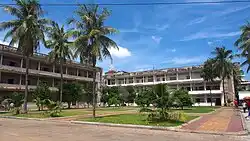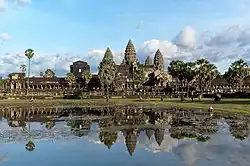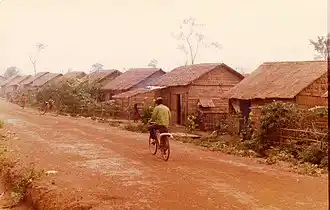
The Cambodian genocide was a genocide that was carried out in Cambodia by the Khmer Rouge regime between 1975 and 1979. It was one of the worst genocides in history, resulting in the deaths of between 1.5 and 2 million Cambodians, roughly between 20% and 25% of the entire Cambodian population at the time that it commenced in 1975. The Cambodian genocide was also one of the strangest episodes of mass death in modern times. Most genocides are committed along racial or religious lines, with one groups trying to utterly destroy another group which they perceive as demonstrably different to themselves. In the case of the Cambodian genocide there was no such racial or religious divide. It was Cambodians killing other Cambodians, with the main motive being a perceived ideological divide based on a very strange interpretation of Marxist thought. The genocide triggered a wave of mass migration from Cambodia, with hundreds of thousands of people fleeing into neighboring countries, particularly Thailand. This went on for many years after the genocide ended as the Khmer Rouge’s reign of terror culminated in Vietnam invading and occupying Cambodia until the early 1990s.[1]
Cambodian genocide chronology of eventsCambodian genocide chronology of events

Cambodia was once the thriving heart of a great civilization, the Khmer Empire. In the thirteenth century its capital, Angkor Wat, was one of the largest cities in the world, perhaps even the largest, with a population of upwards of one million people. The Khmer Empire declined thereafter and like most non-western countries Cambodia succumbed to European imperial domination in the nineteenth century. In Cambodia’s case it was the French who incorporated the country into their growing sphere of influence across Indochina in 1863.[2]
Cambodia, along with Vietnam and Laos, was occupied by the Japanese during the Second World War. After the conflict it was clear that French colonial rule was going to come to an end before long. Like neighboring Vietnam, a number of communist groups emerged in Cambodia from 1946 onwards. One of these was soon joined by a man by the name of Saloth Sâr, a Cambodian who had studied in Paris in the early 1950s and became involved there with the communist Cercle Marxiste, though Sâr had later confessed that while he had read some of the works of Karl Marx, he really didn’t understand much of what Marx had written at all. He is more well-known today by the revolutionary name he later adopted: Pol Pot.[3]
Through the 1950s and 1960s, as it gained its independence from France in 1953 and transitioned to being an independent nation, Cambodia remained a fairly stalwart ally of the western bloc in the Cold War, even as revolutionary movements brewed within the country. When the United States began a covert bombing mission against North Vietnam in 1969, it did so from Cambodia. Just a year later, however, the government was overthrown and the traditional monarchy was dissolved. By then a civil war of sorts was already underway in parts of the country. The divisions and fighting intensified in the early 1970s, eventually bringing to power in 1975 the Khmer Rouge, a communist organization led by Pol Pot.[4]
Pol Pot and his associates in the Khmer Rouge were symptomatic of many regimes that came to power during the Cold War, in so far as the leaders of the organization had only a very limited understanding of Marxist and socialist theories, instead espousing communism principally in order to gain support from the Soviet Union for their cause and because the government they had sought to overthrow seemed to be aligned with the western, US bloc in the Cold War. The limited understanding of communism of the Khmer Rouge was quickly demonstrated in their ideological platform. For instance, at the very core of their ideology was the idea that Cambodia should adopt a form of radical agrarianism where people would abandon the cities and return to agricultural work in the countryside. This is the very antithesis of communism, which advocates for the evolution of industrial society from capitalism to communism, not a reversion to a pre-industrial, agricultural society.[5]
Armed with their bizarrely inverted interpretation of how communism was theoretically supposed to work, Pol Pot and his associates within the Khmer Rouge now set about one of the ghastliest forms of social engineering ever undertaken. In order to implement their radical agrarianism they began forcing people out of the cities and towns and into the countryside. Any resistance was met with imprisonment in one of the nearly 200 prisons established by the regime, institutions from which literally almost nobody escaped alive, with victims often being executed using pickaxes. Academics, businesspeople and anyone associated with ideas that might challenge the regime’s program were targets. Then, influenced by the Chinese Cultural Revolution that had been underway in China since the late 1960s, denunciations and programs of creating a ‘pure’ form of communism followed, leading to spiraling mass murder.[6]
There were some elements of racial and religious prejudice in this genocide, in so far as anyone overtly adhering to any religion was targeted, while Cambodian minorities such as those of Chinese, Vietnamese or Cham ethnicity also became targets. But being an atheist and an ethnic Cambodian were not enough to save individuals either, an unusual feature of this genocide, which usually pits one racial or religious group against another. By early 1979, over 1.5 million people had been mass murdered across the country, out of a pre-genocide population of approximately 7.8 million. It only came to an end when the communist government of Vietnam invaded Cambodia at the very end of 1978, overrunning the country and toppling the Khmer Rouge within the space of two weeks, such was the disordered state of the country by then. A Vietnamese-backed communist regime was imposed for the next decade.[7]
Extent of migration associated with the Cambodian genocideExtent of migration associated with the Cambodian genocide

The genocide unleashed by the Khmer Rouge not only resulted in the deaths of nearly one out of every four Cambodians, it also led to a huge flight of people from the country to escape the regime. Hundreds of thousands left, adding to a general flight of Cambodians between the era when the civil war began in the late 1960s and the end of communist rule in the early 1990s which in total saw approximately one million Cambodians leave the country. Such was the level of mortality and external migration involved that it took until the late 1980s before Cambodia returned to its pre-crisis and pre-genocide population level of nearly eight million people. This was all compounded by a wider refugee crisis in the Indochina region between the 1960s and the 1980s on account of the Vietnam War.[8]
Demographic impact of the Cambodian genocideDemographic impact of the Cambodian genocide
The demographic impact of the migration of Cambodians abroad during the era of the genocide has been felt most keenly in neighboring Thailand. This was a country that was receptive to the influx of Cambodians at the height of the madness unleashed by the Khmer Rouge. There are an estimated two million people in Thailand today who were either born in Cambodia or had parents or grandparents who were.[9] Further afield, tens of thousands of Cambodians acquired refugee status in the United States in the late 1970s and into the 1980s, often after first fleeing to Thailand. The Cambodian American community today is over quarter of a million strong, mostly the product of the 150,000+ Cambodians who arrived to America between 1975 and 1994.[10] Australia also took in well over 10,000 Cambodian refugees, as did numerous other countries in Europe and others parts of Asia. France, the former colonial power, took in over 50,000 Cambodians between the late 1970s and 1989.[11]
See alsoSee also
Explore more about the Cambodian genocideExplore more about the Cambodian genocide
- Khmer Rouge at History.com
- Pol Pot at History.com
- Cambodia at the United States Holocaust Memorial Museum
References
- ↑ https://www.ushmm.org/genocide-prevention/countries/cambodia/cambodia-1975
- ↑ https://www.worldhistory.org/Khmer_Empire/
- ↑ https://www.sciencespo.fr/mass-violence-war-massacre-resistance/en/document/saloth-sar-pol-pot.html
- ↑ https://www.bbc.co.uk/news/world-asia-pacific-13006828
- ↑ https://libcom.org/article/if-we-have-rice-we-can-have-everything-critique-khmer-rouge-ideology-and-practice
- ↑ Ben Kiernan, The Pol Pot Regime: Race, Power and Genocide in Cambodia under the Khmer Rouge, 1975–1979 (Yale, 1996).
- ↑ Thomas Clayton, ‘Cambodians and the occupation: Responses to and perceptions of the Vietnamese occupation, 1979–89’, in South East Asia Research, Vol. 7, No. 3 (November, 1999), pp. 341–363.
- ↑ https://www.history.com/news/vietnam-war-refugees
- ↑ https://gsp.yale.edu/thailands-response-cambodian-genocide
- ↑ https://oxfordre.com/americanhistory/display/10.1093/acrefore/9780199329175.001.0001/acrefore-9780199329175-e-317
- ↑ G. D. M. Wijers, ‘The reception of Cambodian refugees in France’, in Journal of Refugee Studies, Vol. 24, No. 2 (May, 2011), pp. 239–255.

